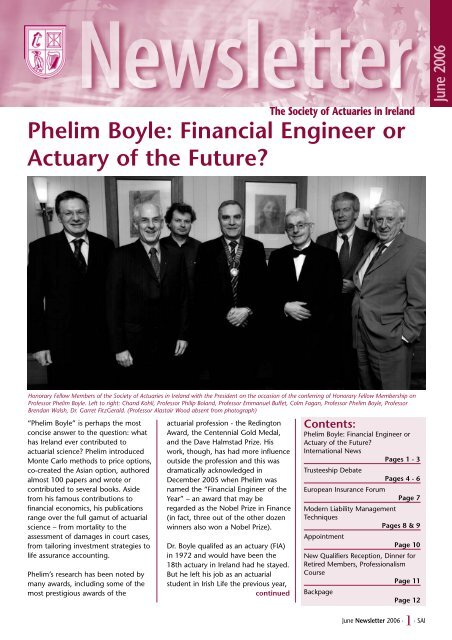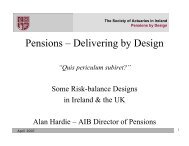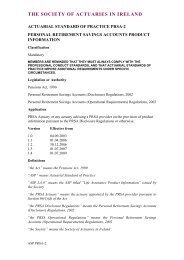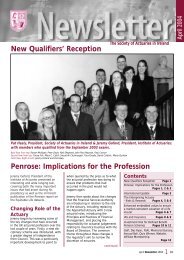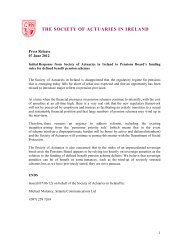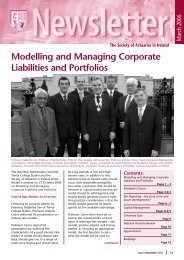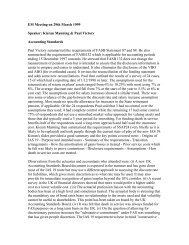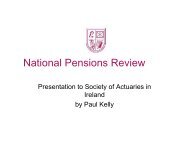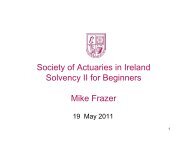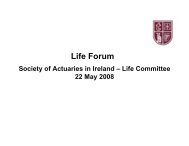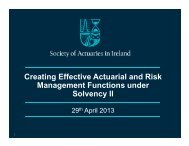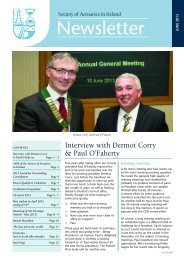Newsletter June 2006.pdf - Society of Actuaries in Ireland
Newsletter June 2006.pdf - Society of Actuaries in Ireland
Newsletter June 2006.pdf - Society of Actuaries in Ireland
- No tags were found...
You also want an ePaper? Increase the reach of your titles
YUMPU automatically turns print PDFs into web optimized ePapers that Google loves.
The <strong>Society</strong> <strong>of</strong> <strong>Actuaries</strong> <strong>in</strong> <strong>Ireland</strong><br />
The <strong>Society</strong> <strong>of</strong> <strong>Actuaries</strong> <strong>in</strong> <strong>Ireland</strong><br />
Phelim Boyle: F<strong>in</strong>ancial Eng<strong>in</strong>eer or<br />
Actuary <strong>of</strong> the Future<br />
<strong>June</strong> 2006<br />
Honorary Fellow Members <strong>of</strong> the <strong>Society</strong> <strong>of</strong> <strong>Actuaries</strong> <strong>in</strong> <strong>Ireland</strong> with the President on the occasion <strong>of</strong> the conferr<strong>in</strong>g <strong>of</strong> Honorary Fellow Membership on<br />
Pr<strong>of</strong>essor Phelim Boyle. Left to right: Chand Kohli, Pr<strong>of</strong>essor Philip Boland, Pr<strong>of</strong>essor Emmanuel Buffet, Colm Fagan, Pr<strong>of</strong>essor Phelim Boyle, Pr<strong>of</strong>essor<br />
Brendan Walsh, Dr. Garret FitzGerald. (Pr<strong>of</strong>essor Alastair Wood absent from photograph)<br />
“Phelim Boyle” is perhaps the most<br />
concise answer to the question: what<br />
has <strong>Ireland</strong> ever contributed to<br />
actuarial science Phelim <strong>in</strong>troduced<br />
Monte Carlo methods to price options,<br />
co-created the Asian option, authored<br />
almost 100 papers and wrote or<br />
contributed to several books. Aside<br />
from his famous contributions to<br />
f<strong>in</strong>ancial economics, his publications<br />
range over the full gamut <strong>of</strong> actuarial<br />
science – from mortality to the<br />
assessment <strong>of</strong> damages <strong>in</strong> court cases,<br />
from tailor<strong>in</strong>g <strong>in</strong>vestment strategies to<br />
life assurance account<strong>in</strong>g.<br />
Phelim’s research has been noted by<br />
many awards, <strong>in</strong>clud<strong>in</strong>g some <strong>of</strong> the<br />
most prestigious awards <strong>of</strong> the<br />
actuarial pr<strong>of</strong>ession - the Red<strong>in</strong>gton<br />
Award, the Centennial Gold Medal,<br />
and the Dave Halmstad Prize. His<br />
work, though, has had more <strong>in</strong>fluence<br />
outside the pr<strong>of</strong>ession and this was<br />
dramatically acknowledged <strong>in</strong><br />
December 2005 when Phelim was<br />
named the “F<strong>in</strong>ancial Eng<strong>in</strong>eer <strong>of</strong> the<br />
Year” – an award that may be<br />
regarded as the Nobel Prize <strong>in</strong> F<strong>in</strong>ance<br />
(<strong>in</strong> fact, three out <strong>of</strong> the other dozen<br />
w<strong>in</strong>ners also won a Nobel Prize).<br />
Dr. Boyle qualifed as an actuary (FIA)<br />
<strong>in</strong> 1972 and would have been the<br />
18th actuary <strong>in</strong> <strong>Ireland</strong> had he stayed.<br />
But he left his job as an actuarial<br />
student <strong>in</strong> Irish Life the previous year,<br />
cont<strong>in</strong>ued<br />
Contents:<br />
Phelim Boyle: F<strong>in</strong>ancial Eng<strong>in</strong>eer or<br />
Actuary <strong>of</strong> the Future<br />
International News<br />
Pages 1 - 3<br />
Trusteeship Debate<br />
Pages 4 - 6<br />
European Insurance Forum<br />
Page 7<br />
Modern Liability Management<br />
Techniques<br />
Pages 8 & 9<br />
Appo<strong>in</strong>tment<br />
Page 10<br />
New Qualifiers Reception, D<strong>in</strong>ner for<br />
Retired Members, Pr<strong>of</strong>essionalism<br />
Course<br />
Page 11<br />
Backpage<br />
Page 12<br />
<strong>June</strong> <strong>Newsletter</strong> 2006 · 1 · SAI
Phelim Boyle: F<strong>in</strong>ancial Eng<strong>in</strong>eer or Actuary <strong>of</strong><br />
hav<strong>in</strong>g played a role <strong>in</strong> convert<strong>in</strong>g<br />
the <strong>in</strong>dustrial branch premiums <strong>in</strong>to<br />
the new decimal system, to move to<br />
the comparatively excit<strong>in</strong>g position as<br />
pension consultant at the Liverpool<br />
<strong>of</strong>fice <strong>of</strong> the consult<strong>in</strong>g actuaries,<br />
Duncan C. Fraser & Co. However, he<br />
did not stay long <strong>in</strong> that position but<br />
moved aga<strong>in</strong> <strong>in</strong> 1973 to Canada, first<br />
for an academic position with the<br />
University <strong>of</strong> British Columbia and<br />
then, almost a decade later, to the<br />
University <strong>of</strong> Waterloo where he<br />
rema<strong>in</strong>s as the J. Page R. Wadsworth<br />
Pr<strong>of</strong>essor <strong>of</strong> F<strong>in</strong>ance. While his career<br />
change to academia was facilitated<br />
by the PhD <strong>in</strong> Relativity he ga<strong>in</strong>ed<br />
from Tr<strong>in</strong>ity College Dubl<strong>in</strong> <strong>in</strong> 1970,<br />
his teach<strong>in</strong>g and research was always<br />
to be <strong>in</strong> f<strong>in</strong>ance and actuarial science.<br />
The <strong>Society</strong> <strong>of</strong> <strong>Actuaries</strong> <strong>in</strong> <strong>Ireland</strong><br />
celebrated Pr<strong>of</strong>essor Boyle’s career on<br />
22nd March 2006 when Phelim was<br />
made the 7th Honorary Fellow <strong>of</strong> the<br />
<strong>Society</strong>. Inevitably, he drew a large<br />
crowd, some <strong>of</strong> whom were his<br />
former work colleagues from his<br />
student days with Irish Life. Prior to<br />
receiv<strong>in</strong>g his fellowship, Phelim set<br />
out <strong>in</strong> his understated manner the<br />
major threat to our pr<strong>of</strong>ession with<br />
his address, F<strong>in</strong>ancial Eng<strong>in</strong>eers are<br />
Here to Stay.<br />
F<strong>in</strong>ancial eng<strong>in</strong>eers use modern<br />
theories <strong>in</strong> f<strong>in</strong>ance, coupled with<br />
sophisticated mathematics and<br />
numerical methods, to create and<br />
manage desirable f<strong>in</strong>ancial products.<br />
In a job brief that is uncomfortably<br />
similar to that <strong>of</strong> an actuary’s, he<br />
outl<strong>in</strong>ed how they design, construct<br />
and price products <strong>in</strong> trad<strong>in</strong>g rooms,<br />
model and construct hedges, develop<br />
trad<strong>in</strong>g strategies to mitigate risk and<br />
build risk management systems.<br />
Quite simply, f<strong>in</strong>ancial eng<strong>in</strong>eers<br />
answer a demand for sophisticated<br />
f<strong>in</strong>ancial products, <strong>of</strong>ten with<br />
embedded guarantees and options.<br />
Actuarial science, <strong>of</strong> course, used<br />
cutt<strong>in</strong>g-edge mathematics at the time<br />
<strong>of</strong> its genesis – probability, compound<br />
SAI · 2 · <strong>June</strong> <strong>Newsletter</strong> 2006<br />
<strong>in</strong>terest and mortality – to create<br />
desirable products. Like today, those<br />
products had embedded options and<br />
guarantees – the option <strong>of</strong><br />
cont<strong>in</strong>uation on set terms and a<br />
guarantee on benefits. However, the<br />
limitations <strong>of</strong> the technology <strong>of</strong> the<br />
time required the pool<strong>in</strong>g <strong>of</strong> money<br />
so it loses its identification with an<br />
<strong>in</strong>dividual, which, when coupled with<br />
the commercial requirement to add<br />
marg<strong>in</strong>s, created surplus and the<br />
need to allocate it. The pool<strong>in</strong>g<br />
system delivers collective security but<br />
at the cost <strong>of</strong> a rough justice – and,<br />
he emphasized, <strong>of</strong>ten we don’t know<br />
just how rough that justice is. The<br />
pool<strong>in</strong>g system, with its associated<br />
lack <strong>of</strong> transparency and broad<br />
attempt at <strong>in</strong>dividual equity, is now<br />
out <strong>of</strong> step with market demands.<br />
Crucially, though, the guarantees that<br />
are now demanded by the market fit<br />
uneasily <strong>in</strong> the pool<strong>in</strong>g system.<br />
Quot<strong>in</strong>g Red<strong>in</strong>gton on the “thorny<br />
area <strong>of</strong> guarantees” which “attempt<br />
to borrow from the pool<strong>in</strong>g system”,<br />
he concluded with Red<strong>in</strong>gton that<br />
such developments are “naturally<br />
troublesome” <strong>in</strong> the with pr<strong>of</strong>its<br />
model. Dr. Boyle argued that the<br />
optimal modern contract design is<br />
unit-l<strong>in</strong>ked with guarantees –<br />
comb<strong>in</strong><strong>in</strong>g the demands for<br />
transparency and <strong>in</strong>dividual equity,<br />
with security provided through the<br />
guarantees.<br />
So what toolkit, aside from<br />
mathematical aptitude, is necessary<br />
to design and manage such products<br />
Phelim outl<strong>in</strong>ed the “magnificent<br />
seven” <strong>in</strong>sights that f<strong>in</strong>ancial<br />
economics has given over the last<br />
half-century (see box). Perhaps the<br />
surprise on the list is portfolio<br />
selection <strong>in</strong> cont<strong>in</strong>uous time, the field<br />
created by Merton, but Phelim <strong>in</strong>sists<br />
that this was not there just to make<br />
up the number but that “Merton’s<br />
model is as beautiful as the Black-<br />
Scholes-Merton formula” and<br />
necessary to cope with dynamic<br />
<strong>in</strong>vestment conditions.<br />
Key Ideas <strong>in</strong> F<strong>in</strong>ance:<br />
the Magnificent Seven<br />
1. The No-Arbitrage Pr<strong>in</strong>ciple: two<br />
identical cashflows must have the<br />
same price.<br />
2. Mean-Variance Portfolio<br />
Selection: if <strong>in</strong>vestment reward is<br />
taken to be the expected return<br />
and <strong>in</strong>vestment risk to be the<br />
standard deviation <strong>of</strong> returns,<br />
and we know these values, then<br />
portfolio selection is a relatively<br />
straightforward optimisation<br />
problem.<br />
3. Capital Structure Irrelevance: the<br />
ideal capital structure <strong>of</strong> a firm<br />
(the optimum debt/equity mix)<br />
does not exist (under certa<strong>in</strong><br />
assumptions).<br />
4. The Capital Asset Pric<strong>in</strong>g Model:<br />
a theory that accounts for an<br />
<strong>in</strong>dividual asset’s ex-ante excess<br />
return (over the risk-free rate) as<br />
related l<strong>in</strong>early to the expected<br />
excess returns from all risky<br />
assets.<br />
5. Equilibrium: the notion that the<br />
expected return and therefore<br />
the expected price evolution <strong>of</strong> a<br />
risky asset is a function <strong>of</strong> its<br />
relationship with all other risky<br />
assets as captured by CAPM or<br />
other market pric<strong>in</strong>g models.<br />
6. The Black-Scholes-Merton Option<br />
Pric<strong>in</strong>g Formula.<br />
7. Portfolio Selection <strong>in</strong> Cont<strong>in</strong>uous<br />
Time: a key result is that a risk<br />
averse <strong>in</strong>vestor who wishes to<br />
maximise expected utility will,<br />
under certa<strong>in</strong> assumptions,<br />
ma<strong>in</strong>ta<strong>in</strong> a constant fraction <strong>of</strong><br />
their wealth <strong>in</strong> risky assets, the<br />
fixed proportion given by the<br />
Merton ratio. i.e., [risk premium<br />
on risky assets]/[variance <strong>of</strong> risky<br />
asset returns x <strong>in</strong>dividual’s<br />
relative risk aversion factor]
the Future...cont<strong>in</strong>ued<br />
International News<br />
Phelim took us through an optimal<br />
contract design he was work<strong>in</strong>g on<br />
with a collaborator, Weidong Tian. It<br />
was an unapologetic academic<br />
treatment that attempted to squarethe-circle<br />
<strong>of</strong> a product that maximises<br />
the policyholder’s utility subject to a<br />
maturity guarantee and, with a set<br />
probability level, delivers the upside<br />
<strong>of</strong> an equity <strong>in</strong>dex. This is a<br />
generalisation <strong>of</strong> the standard<br />
guaranteed equity tracker and he<br />
briefly explored under what<br />
conditions the product exists.<br />
He concluded his address by argu<strong>in</strong>g<br />
that f<strong>in</strong>ancial eng<strong>in</strong>eers and actuaries<br />
can learn a lot from one another.<br />
While the examples he employed<br />
were drawn from <strong>in</strong>surance, his<br />
arguments carried through to<br />
pension schemes. F<strong>in</strong>ancial eng<strong>in</strong>eers<br />
are strong on technique but actuaries<br />
– the oldest risk management<br />
pr<strong>of</strong>ession <strong>in</strong> the world – have the<br />
advantages <strong>of</strong> quality control <strong>in</strong><br />
technical competencies,<br />
pr<strong>of</strong>essionalism and discipl<strong>in</strong>e. He<br />
f<strong>in</strong>ished with a question: can we<br />
comb<strong>in</strong>e the best <strong>of</strong> both worlds<br />
It was clear by the end <strong>of</strong> his address<br />
that the threat to our pr<strong>of</strong>ession was<br />
not f<strong>in</strong>ancial eng<strong>in</strong>eers but our own<br />
<strong>in</strong>ertia. While a young pupil <strong>in</strong><br />
Dreenan School <strong>in</strong> County Derry,<br />
Phelim was nick-named the Bard <strong>of</strong><br />
Armagh but his message was first put<br />
<strong>in</strong> verse by another Irish poet:<br />
It seems aga<strong>in</strong> that it is time to learn,<br />
In this untir<strong>in</strong>g, crumbl<strong>in</strong>g place<br />
<strong>of</strong> growth<br />
To which, for the time be<strong>in</strong>g, I return.<br />
Group Consultatif e<strong>Newsletter</strong><br />
This <strong>Newsletter</strong> is an excellent<br />
summary <strong>of</strong> current <strong>in</strong>ternational<br />
matters that are likely to affect<br />
actuaries over the next few years.<br />
It has both technical and general<br />
content. It is available on the<br />
Groupe Consultatif's website<br />
www.gcactuaries.org/enews10.html<br />
IAA Life Section<br />
If you wish to jo<strong>in</strong> the new IAA Life<br />
Section, please contact the<br />
<strong>Society</strong>.<br />
International Presidents’ Meet<strong>in</strong>g<br />
Every six months, a meet<strong>in</strong>g or<br />
"forum" <strong>of</strong> the presidents <strong>of</strong><br />
actuarial associations worldwide<br />
takes place <strong>in</strong> conjunction with<br />
other meet<strong>in</strong>gs <strong>of</strong> the IAA<br />
(International Actuarial Association).<br />
The next Presidents' Forum takes<br />
place <strong>in</strong> Paris on Sunday 28 May.<br />
It will be focus<strong>in</strong>g on six topics<br />
identified at its last meet<strong>in</strong>g as key<br />
priorities for the IAA and its<br />
member associations:<br />
• Actuarial <strong>in</strong>volvement <strong>in</strong> bank<strong>in</strong>g<br />
and f<strong>in</strong>ancial management<br />
• Risk management<br />
• Education and CPD (<strong>in</strong>clud<strong>in</strong>g<br />
the proposed development <strong>of</strong> an<br />
International Actuarial Education<br />
Programme)<br />
• Brand<strong>in</strong>g and market<strong>in</strong>g the<br />
actuarial pr<strong>of</strong>ession<br />
• Operations and governance<br />
with<strong>in</strong> the IAA (<strong>in</strong>clud<strong>in</strong>g the<br />
relationship between the IAA<br />
and its member associations<br />
around the world)<br />
• Value added by the IAA<br />
The Forum will be attended by<br />
presidents <strong>of</strong> 48 actuarial<br />
associations from all over the world,<br />
<strong>in</strong>clud<strong>in</strong>g Colm Fagan, represent<strong>in</strong>g<br />
the <strong>Society</strong> <strong>of</strong> <strong>Actuaries</strong> <strong>in</strong> <strong>Ireland</strong>.<br />
Thomas K<strong>in</strong>sella, Mirror <strong>in</strong> February.<br />
Shane Whelan<br />
<strong>June</strong> <strong>Newsletter</strong> 2006 · 3· SAI
Trusteeship Debate<br />
On 2 March, the President Colm<br />
Fagan chaired a debate on Trusteeship<br />
<strong>in</strong> <strong>Ireland</strong>. Jimmy Joyce and Patrick<br />
Burke spoke on the proposition that<br />
“Trusteeship Contributes Positively to<br />
Pension Scheme Governance” while<br />
David K<strong>in</strong>gston’s and Ciaran Long’s<br />
proposition was that “The Trusteeship<br />
Model Requires Fundamental Reform.”<br />
Jimmy Joyce<br />
Jimmy outl<strong>in</strong>ed that, <strong>in</strong> his experience,<br />
the current trusteeship model had a<br />
positive effect and that the<br />
<strong>in</strong>volvement <strong>of</strong> trustees assisted <strong>in</strong><br />
good governance <strong>of</strong> schemes. He felt<br />
that trustees should seek the advice<br />
<strong>of</strong> experts, as necessary, and engage<br />
<strong>in</strong> robust dialogue with those experts<br />
to ensure that trustees are provided<br />
with all relevant <strong>in</strong>formation required<br />
to carry out their role.<br />
One <strong>of</strong> the trustees’ key roles is to<br />
provide security for members’ accrued<br />
benefits and to ensure pension<br />
schemes are managed separately<br />
from the bus<strong>in</strong>ess <strong>of</strong> the employer.<br />
In the absence <strong>of</strong> trustees, this<br />
<strong>in</strong>dependent role would be removed<br />
and any changes underm<strong>in</strong><strong>in</strong>g<br />
trusteeship may result <strong>in</strong> the removal<br />
<strong>of</strong> <strong>in</strong>dependent <strong>in</strong>termediaries.<br />
Jimmy felt that the greater question<strong>in</strong>g<br />
<strong>of</strong> the role <strong>of</strong> the trustee was partially<br />
as a result <strong>of</strong> a desire to look for a<br />
scapegoat for recent problems<br />
experienced by Irish pension schemes<br />
and that this was unproductive.<br />
Instead, he believes it is important to<br />
accept that it was a comb<strong>in</strong>ation <strong>of</strong><br />
circumstances that had led to the<br />
current problems rather than a fail<strong>in</strong>g<br />
<strong>of</strong> any particular party.<br />
He felt the role <strong>of</strong> the trustee was to<br />
act as sceptical questioner <strong>of</strong> the<br />
adviser and that the problems which<br />
had arisen <strong>in</strong> the <strong>in</strong>dustry as <strong>of</strong> late<br />
were primarily due to the general<br />
structure <strong>of</strong> the Irish model rather<br />
than necessarily trusteeship <strong>in</strong> itself<br />
and that, <strong>in</strong> the current environment,<br />
trustees have a valuable role to play<br />
<strong>in</strong> manag<strong>in</strong>g the risks associated with<br />
pension schemes.<br />
He stated that, <strong>in</strong> the current climate,<br />
trustees should ensure that they do<br />
not play a passive role and they<br />
should become more engaged <strong>in</strong><br />
ensur<strong>in</strong>g the good governance <strong>of</strong><br />
schemes. To do this effectively,<br />
trustees would need the assistance <strong>of</strong><br />
the various experts associated with<br />
the runn<strong>in</strong>g <strong>of</strong> pension schemes.<br />
Jimmy stated that there was also a<br />
conflict between the amount <strong>of</strong><br />
<strong>in</strong>formation that was provided to<br />
members and the associated costs. In<br />
some cases, he felt that the regulator<br />
was putt<strong>in</strong>g too much emphasis on<br />
provid<strong>in</strong>g <strong>in</strong>formation which was <strong>of</strong><br />
limited use but which substantially<br />
<strong>in</strong>creased the costs associated with<br />
runn<strong>in</strong>g the pension scheme.<br />
Overall, Jimmy’s view was that the<br />
role <strong>of</strong> the trustee was now more<br />
useful and relevant than ever before<br />
and that, while there were alternative<br />
models, trusteeship still provided the<br />
best option and that this was equally<br />
as applicable to def<strong>in</strong>ed contribution<br />
plans.<br />
David K<strong>in</strong>gston<br />
David spoke <strong>in</strong> favour <strong>of</strong> the reform<br />
<strong>of</strong> the trusteeship model. He felt that,<br />
prior to the last 5-10 years, there had<br />
been a great amount <strong>of</strong> stability<br />
with<strong>in</strong> the pensions <strong>in</strong>dustry. However,<br />
<strong>in</strong> recent years there had been<br />
significant changes and <strong>in</strong> light <strong>of</strong> the<br />
new circumstances there was a need<br />
to review the exist<strong>in</strong>g trusteeship<br />
model.<br />
With<strong>in</strong> the trusteeship model David<br />
saw a marked contrast between large<br />
schemes and small schemes and felt<br />
that for small/medium schemes the<br />
trusteeship model was not work<strong>in</strong>g<br />
very well. He felt that, <strong>in</strong> light <strong>of</strong><br />
recent changes, there needs to be<br />
significant re-exam<strong>in</strong>ation <strong>of</strong> the role<br />
<strong>of</strong> the trustees and also how they<br />
<strong>in</strong>teract with the employer.<br />
His contention was that rather than<br />
try<strong>in</strong>g to act as the management <strong>of</strong> a<br />
pension scheme, the trustees would<br />
be better act<strong>in</strong>g <strong>in</strong> an oversight role<br />
i.e. effectively act<strong>in</strong>g as a nonexecutive<br />
director would do with<strong>in</strong> a<br />
normal company management<br />
structure. He felt that while the<br />
trustees did not have the capacity to<br />
make detailed f<strong>in</strong>ancial decisions<br />
themselves, they were strongly<br />
positioned to question and query<br />
those decisions made by the<br />
management <strong>of</strong> the company or, <strong>in</strong><br />
this case, the management <strong>of</strong> the<br />
pension scheme and play a useful<br />
role <strong>in</strong> this capacity.<br />
He suggested that while this role had<br />
been well fulfilled <strong>in</strong> the case <strong>of</strong> some<br />
large pension schemes, as schemes<br />
get smaller this process becomes far<br />
less satisfactory. He also felt that <strong>in</strong><br />
many such cases the trustees may not<br />
fully understand the risks and as such<br />
the current role <strong>of</strong> the trustees act<strong>in</strong>g<br />
as the management <strong>of</strong> a pension<br />
scheme is not suitable.<br />
As a result, David believes a change<br />
should be made to the role <strong>of</strong> trustees<br />
to address the fact that the<br />
trusteeship model is not work<strong>in</strong>g for a<br />
vast majority <strong>of</strong> Irish pension schemes<br />
and requires significant reform.<br />
Patrick Burke<br />
Similar to Jimmy, Patrick spoke <strong>in</strong><br />
favour <strong>of</strong> the exist<strong>in</strong>g trusteeship<br />
model.<br />
His view was that trustees, as an<br />
<strong>in</strong>dependent group, have a valuable<br />
role to play and that they are well<br />
placed to manage the risks associated<br />
with pension schemes. He stated that<br />
given the current focus on good<br />
governance, the trustees had a far<br />
SAI · 4 · <strong>June</strong> <strong>Newsletter</strong> 2006
greater role to play <strong>in</strong> pension<br />
schemes go<strong>in</strong>g forward than<br />
heret<strong>of</strong>ore. He noted that <strong>in</strong> present<br />
circumstances, where legislation and<br />
regulations are becom<strong>in</strong>g far more<br />
complex, the trusteeship model<br />
<strong>of</strong>fered the flexibility and the<br />
<strong>in</strong>dependent capacity to deal with<br />
these matters effectively.<br />
He stated that this view was<br />
supported by a wide variety <strong>of</strong><br />
reports and <strong>in</strong>vestigations carried out<br />
around the world and <strong>in</strong> particular<br />
the Myners review <strong>in</strong> the UK which<br />
found that the trust based model<br />
provided the framework for good<br />
governance and protection <strong>of</strong><br />
members’ rights.<br />
He felt that if we adopted a contract<br />
based model to replace trusteeship<br />
there would be far more complications<br />
than under the trusteeship approach<br />
and that the positive features <strong>of</strong> the<br />
exist<strong>in</strong>g model would be lost.<br />
In Patrick’s view, pension schemes<br />
(and especially def<strong>in</strong>ed benefit<br />
schemes) have changed very rapidly<br />
over recent years. As a result, some <strong>of</strong><br />
the fundamentals that actuaries and<br />
other third parties <strong>in</strong>volved <strong>in</strong><br />
manag<strong>in</strong>g pension schemes had<br />
understood for years had changed<br />
quite quickly. With<strong>in</strong> this flux the<br />
trustees were not experts and had no<br />
greater wisdom than the other parties<br />
<strong>in</strong>volved <strong>in</strong> pension schemes and<br />
Patrick acknowledged that the effect<br />
<strong>of</strong> these changes was to put greater<br />
pressure on the trusteeship model.<br />
However, he still felt that the<br />
trusteeship model provided the best<br />
available approach. It provided a<br />
degree <strong>of</strong> flexibility and adaptability<br />
by giv<strong>in</strong>g the trustees the discretion<br />
to deal with issues as they arise. It<br />
also meant that they could be <strong>in</strong> a<br />
position to make difficult decisions<br />
and deal with the various pressures as<br />
<strong>in</strong>dependent bodies outside the<br />
direct <strong>in</strong>fluence <strong>of</strong> the company<br />
and/or the members. He said that<br />
while the trusteeship model was the<br />
best available, it does need help. In<br />
their role as protector <strong>of</strong> the<br />
members’ <strong>in</strong>terests, the trustees need<br />
to get a greater degree <strong>of</strong> assistance<br />
from the advisers <strong>of</strong> their pension<br />
scheme.<br />
In the case <strong>of</strong> def<strong>in</strong>ed contribution<br />
schemes, Patrick felt that if<br />
trusteeship was removed then this<br />
would lead to the over regulation <strong>of</strong><br />
small def<strong>in</strong>ed contribution schemes<br />
and that it would remove an<br />
important resource for pension<br />
scheme members.<br />
His view was that there was not a<br />
need for fundamental reform <strong>of</strong> the<br />
exist<strong>in</strong>g trusteeship model but there<br />
was a need to evolve the exist<strong>in</strong>g<br />
system <strong>of</strong> trusteeship. He felt, overall,<br />
that there was scope to improve the<br />
trusteeship model for def<strong>in</strong>ed benefit<br />
schemes to make use <strong>of</strong> the degree <strong>of</strong><br />
flexibility and that, for def<strong>in</strong>ed<br />
contributions schemes, the legislative<br />
or contractual route was simply not<br />
adequate to properly safeguard<br />
members’ <strong>in</strong>terests.<br />
Ciaran Long<br />
The last speaker was Ciaran Long,<br />
who along with David, spoke <strong>in</strong><br />
favour <strong>of</strong> reform <strong>of</strong> the trusteeship<br />
model. Ciaran felt that trusteeship<br />
was a large barrier to expand<strong>in</strong>g<br />
pension coverage <strong>in</strong> <strong>Ireland</strong>.<br />
His view is that trusteeship is no<br />
longer suitable to deal with the<br />
current environment fac<strong>in</strong>g Irish<br />
pension schemes. He acknowledged<br />
that while there is a role for<br />
trusteeship <strong>in</strong> large def<strong>in</strong>ed benefit<br />
schemes, there is a need to review<br />
the exist<strong>in</strong>g structure for those<br />
schemes. With<strong>in</strong> def<strong>in</strong>ed contribution<br />
schemes he felt that there is no<br />
longer a role for trusteeship,<br />
particularly for the smaller sized<br />
schemes which are more typical <strong>in</strong><br />
<strong>Ireland</strong>. However, Ciaran did feel that<br />
the super trust concept recently<br />
advocated by the National Association<br />
<strong>of</strong> Pension Funds <strong>in</strong> the UK and <strong>in</strong><br />
operation <strong>in</strong> Australia had some merit<br />
and would benefit from some further<br />
debate <strong>in</strong> the Irish context. He felt<br />
that the key issues that demonstrated<br />
why fundamental reform was needed<br />
were the issues <strong>of</strong> pensions coverage,<br />
the degree <strong>of</strong> regulation,<br />
simplification and also the current<br />
position <strong>of</strong> trusteeship.<br />
He felt that it was very difficult under<br />
the exist<strong>in</strong>g regime for small<br />
bus<strong>in</strong>esses to deal with the<br />
complexities <strong>of</strong> the current<br />
trusteeship model. In many such<br />
bus<strong>in</strong>esses, one employee effectively<br />
comb<strong>in</strong>es the role <strong>of</strong> CEO, f<strong>in</strong>ancial<br />
manager and HR manager and does<br />
not have the capacity to try and deal<br />
with the various complexities <strong>of</strong><br />
pension matters. For these bus<strong>in</strong>esses<br />
(which are very prevalent <strong>in</strong> <strong>Ireland</strong>),<br />
the trusteeship model is not work<strong>in</strong>g.<br />
Ciaran felt that, <strong>in</strong> review<strong>in</strong>g pension<br />
coverage, the danger is that we end<br />
up look<strong>in</strong>g at larger companies rather<br />
than try<strong>in</strong>g to understand the real<br />
world <strong>of</strong> surviv<strong>in</strong>g with<strong>in</strong> a small<br />
bus<strong>in</strong>ess environment. Instead <strong>of</strong><br />
focus<strong>in</strong>g on the needs <strong>of</strong> smaller<br />
employers we assume that all<br />
employers have HR departments<br />
and/or pension managers who can<br />
manage complicated pension<br />
schemes, operate trusts and still be<br />
able to focus on their own bus<strong>in</strong>ess.<br />
Instead he advocated a simpler<br />
contractual model for these<br />
bus<strong>in</strong>esses broadly along the l<strong>in</strong>es <strong>of</strong><br />
an SSIA type model with no trust, no<br />
complex tax relief system - just simple<br />
personal contracts. He felt that there<br />
was an over fixation on costs and<br />
consumer protection by hav<strong>in</strong>g<br />
excessive legislation for low cost<br />
cont<strong>in</strong>ued<br />
<strong>June</strong> <strong>Newsletter</strong> 2006 · 5· SAI
Trusteeship Debate...cont<strong>in</strong>ued<br />
products - no one actually wants to<br />
sell or provide these products and as<br />
a result there is no one buy<strong>in</strong>g them.<br />
He felt that the second problem is<br />
that there is too much complexity<br />
forced on these models by the<br />
regulator and then, effectively, no<br />
consumer can understand them.<br />
Discussion<br />
At this po<strong>in</strong>t the debate concluded<br />
and the topic was opened to the floor.<br />
Overall, there was a general view that<br />
trusteeship worked well for large<br />
def<strong>in</strong>ed benefit pension schemes.<br />
However, there was a feel<strong>in</strong>g that for<br />
small arrangements a PRSA or<br />
regulatory approach might be better<br />
suited to meet the needs <strong>of</strong> these<br />
employers and employees. It was also<br />
noted that the Australian model may<br />
comb<strong>in</strong>e many <strong>of</strong> the better features<br />
<strong>of</strong> trusteeship comb<strong>in</strong>ed with the<br />
lower costs associated with a large<br />
scale model.<br />
There was further recognition that<br />
amongst smaller employers the<br />
current model did result <strong>in</strong> higher<br />
adm<strong>in</strong>istration costs. However, for the<br />
larger schemes, trusteeship did<br />
provide a greater degree <strong>of</strong><br />
governance and corporate control<br />
and, <strong>in</strong> many cases, what we need to<br />
be look<strong>in</strong>g at is the balance <strong>of</strong><br />
powers so as to ensure that the<br />
employer has sufficient power and<br />
authority <strong>in</strong> the trust deed to facilitate<br />
the runn<strong>in</strong>g <strong>of</strong> their pension schemes,<br />
rather than be<strong>in</strong>g excessively driven<br />
at times by the trustees.<br />
The Vote<br />
In the end it was agreed that two<br />
separate votes would be taken; the<br />
first was that the role <strong>of</strong> trusteeship <strong>in</strong><br />
def<strong>in</strong>ed benefit schemes needed<br />
substantial review. This motion was<br />
strongly rejected. The second was<br />
that there was a need for reform <strong>of</strong><br />
the trusteeship role <strong>in</strong> def<strong>in</strong>ed<br />
contribution schemes and this motion<br />
was narrowly carried.<br />
Ollie Coakley and<br />
Kieran Mann<strong>in</strong>g<br />
SAI Report on Pr<strong>of</strong>essionalism<br />
Issues for the IAA Pr<strong>of</strong>essionalism<br />
Committee Meet<strong>in</strong>g<br />
Paris – 27 May 2006<br />
The above report, which is available<br />
on the members’ section <strong>of</strong> the<br />
<strong>Society</strong>’s website, gives an update<br />
on the follow<strong>in</strong>g items:<br />
• Standard-sett<strong>in</strong>g;<br />
• Membership <strong>of</strong> the UK actuarial<br />
pr<strong>of</strong>ession;<br />
• CPD scheme;<br />
• Practis<strong>in</strong>g certificates;<br />
• Discipl<strong>in</strong>ary scheme;<br />
• Pr<strong>of</strong>essional conduct standards;<br />
• Compliance monitor<strong>in</strong>g for<br />
scheme actuaries;<br />
• Conflicts <strong>of</strong> <strong>in</strong>terest; and<br />
• Guidance review.<br />
Before round<strong>in</strong>g <strong>of</strong>f the debate with a<br />
vote (or two!), Colm thanked each <strong>of</strong><br />
the speakers for a thought provok<strong>in</strong>g<br />
meet<strong>in</strong>g. In particular, he thanked the<br />
only non actuary, Patrick Burke<br />
(a lawyer), for participat<strong>in</strong>g.<br />
SAI · 6 · <strong>June</strong> <strong>Newsletter</strong> 2006
European Insurance Forum:<br />
March 15-16 2006<br />
Left to right: Alex Tully (Irish F<strong>in</strong>ancial Regulator); Tom Doran (Chairman, DIMA); Sarah Goddard (CEO,DIMA); and Stephen Dev<strong>in</strong>e, Transamerica<br />
Given <strong>Ireland</strong>’s <strong>in</strong>creas<strong>in</strong>g importance<br />
<strong>in</strong> the Global Insurance and<br />
Re<strong>in</strong>surance Market, it was perhaps<br />
timely that the European Insurance<br />
Forum returned to Dubl<strong>in</strong> <strong>in</strong> mid<br />
March 2006. Hosted by <strong>in</strong>dustry<br />
group DIMA, this year's theme was<br />
<strong>in</strong>surance markets <strong>in</strong> an uncerta<strong>in</strong><br />
world. The two day event’s overrid<strong>in</strong>g<br />
theme was how the <strong>in</strong>crease <strong>in</strong><br />
natural catastrophes has affected the<br />
global <strong>in</strong>surance and re<strong>in</strong>surance<br />
market.<br />
Topics discussed <strong>in</strong>cluded how to<br />
m<strong>in</strong>imise both human suffer<strong>in</strong>g and<br />
<strong>in</strong>surance losses stemm<strong>in</strong>g from these<br />
natural catastrophes. It considered<br />
threats made to global stability by<br />
terrorism. The forum also <strong>in</strong>cluded<br />
sessions on life securitisations,<br />
re<strong>in</strong>surance regulations and corporate<br />
governance.<br />
The <strong>Society</strong> <strong>of</strong> <strong>Actuaries</strong> had no<br />
<strong>of</strong>ficial <strong>in</strong>volvement <strong>in</strong> the conference<br />
but Life actuaries Stephen Dev<strong>in</strong>e and<br />
Ciara Regan presented sessions on<br />
Re<strong>in</strong>surance Regulation and Critical<br />
Illness respectively.<br />
On perhaps a less <strong>in</strong>surance and/or<br />
actuarial related theme, former<br />
commander <strong>of</strong> the British Army's<br />
Special Air Services Tim Coll<strong>in</strong>s shared<br />
some <strong>of</strong> his views on global terrorism.<br />
In addition Mike Pickens, US <strong>in</strong>surance<br />
adviser to the Iraqi Government, and<br />
Peter Dobbs, Kidnap and Terrorism<br />
Specialist from Aon, also spoke on the<br />
less publicised areas <strong>of</strong> Kidnap and<br />
Ransom Insurance.<br />
Alex Tully spoke about the F<strong>in</strong>ancial<br />
Regulator’s objectives with respect to<br />
the <strong>in</strong>troduction <strong>of</strong> re<strong>in</strong>surance<br />
regulation. He stressed that <strong>Ireland</strong>’s<br />
early adoption <strong>of</strong> the Re<strong>in</strong>surance<br />
directive would “constructively assist<br />
re<strong>in</strong>surance towards full compliance<br />
and provide more certa<strong>in</strong>ty <strong>in</strong> the<br />
market place”. A further key plank <strong>of</strong><br />
the implementation was the<br />
requirement for actuarial certification<br />
<strong>of</strong> Re<strong>in</strong>surance reserves for Life and<br />
non–Life bus<strong>in</strong>ess. Currently only<br />
direct bus<strong>in</strong>ess requires actuarial<br />
certification. This is an area where the<br />
Irish F<strong>in</strong>ancial Regulator is work<strong>in</strong>g<br />
closely with the <strong>Society</strong> <strong>of</strong> <strong>Actuaries</strong>.<br />
Patrick Grealy<br />
For further <strong>in</strong>formation on the<br />
topics covered, <strong>in</strong>clud<strong>in</strong>g the slides<br />
and presentations made at the<br />
European Insurance Forum, please<br />
visit the website<br />
www.european<strong>in</strong>suranceforum.com<br />
As Patrick outl<strong>in</strong>ed <strong>in</strong> his article, the<br />
topics are varied and make for<br />
<strong>in</strong>terest<strong>in</strong>g read<strong>in</strong>g.<br />
<strong>June</strong> <strong>Newsletter</strong> 2006 · 7· SAI
Modern Liability Management Techniques<br />
Introduction<br />
An even<strong>in</strong>g meet<strong>in</strong>g to discuss<br />
“Modern Liability Management<br />
Techniques for Def<strong>in</strong>ed Benefit<br />
Pension Funds” was held on the 4th<br />
April 2006 <strong>in</strong> the Burl<strong>in</strong>gton Hotel.<br />
The meet<strong>in</strong>g was well attended and<br />
the speakers, namely Eamonn Liddy,<br />
Brian Griff<strong>in</strong>, Colm Fitzgerald and Pat<br />
Ryan generated an <strong>in</strong>terest<strong>in</strong>g meet<strong>in</strong>g<br />
with the material they presented.<br />
The speakers discussed the recent<br />
emergence <strong>of</strong> new products and<br />
techniques which could prove useful<br />
<strong>in</strong> help<strong>in</strong>g companies and trustees<br />
manage their def<strong>in</strong>ed benefit pension<br />
liabilities. The presentation focused<br />
on the various <strong>in</strong>struments which<br />
could enable pension schemes to<br />
reduce risk relative to liabilities<br />
without compromis<strong>in</strong>g the expected<br />
return on the asset portfolio.<br />
Presentation<br />
Eamonn Liddy shed light on the two<br />
major drivers beh<strong>in</strong>d the recent<br />
developments <strong>in</strong> the derivatives<br />
market:<br />
• Growth <strong>in</strong> Supply<br />
In recent years, there has been a<br />
significant growth <strong>in</strong> the fixed <strong>in</strong>terest<br />
and derivative markets both <strong>in</strong> the<br />
Eurozone and around the world.<br />
Investors are no longer limited to<br />
<strong>in</strong>vest<strong>in</strong>g <strong>in</strong> conventional bonds<br />
issued by a small list <strong>of</strong> issuers. They<br />
can now choose from a wide universe<br />
<strong>of</strong> fixed <strong>in</strong>terest assets restricted by<br />
their own requirements (e.g. currency,<br />
duration, liquidity). Similarly,<br />
derivatives are now more accessible<br />
to <strong>in</strong>vestors. As a result, it is now<br />
typically easier, cheaper, more efficient<br />
and more flexible to obta<strong>in</strong> equity,<br />
bond, property and cash returns<br />
us<strong>in</strong>g derivatives rather than <strong>in</strong>vest<strong>in</strong>g<br />
<strong>in</strong> the underly<strong>in</strong>g assets themselves.<br />
This evolution has now reached the<br />
pensions <strong>in</strong>dustry.<br />
• Growth <strong>in</strong> Demand<br />
The growth <strong>in</strong> demand for various<br />
derivative related products and<br />
techniques has been fuelled ma<strong>in</strong>ly<br />
by sponsors and trustees <strong>in</strong> their<br />
quest to measure and manage<br />
<strong>in</strong>vestment risk and consultants <strong>in</strong><br />
their drive to aid clients elim<strong>in</strong>ate<br />
“unrewarded risk”.<br />
Before <strong>in</strong>vestigat<strong>in</strong>g the types <strong>of</strong><br />
<strong>in</strong>vestment <strong>in</strong>struments that are most<br />
likely to be <strong>of</strong> use to Irish pension<br />
funds <strong>in</strong> manag<strong>in</strong>g their liabilities,<br />
one needs to understand the risks.<br />
The sensitivity <strong>of</strong> pension scheme<br />
liabilities to real <strong>in</strong>terest rates and<br />
<strong>in</strong>flation needs to be measured. The<br />
sensitivity to <strong>in</strong>terest rates can be<br />
captured through the concepts <strong>of</strong>:<br />
• “Duration” – the weighted average<br />
time to each <strong>of</strong> the cashflow po<strong>in</strong>ts;<br />
and<br />
• “Convexity” – the rate <strong>of</strong> change <strong>of</strong><br />
duration with <strong>in</strong>terest rates.<br />
In an ideal world, the asset portfolio<br />
<strong>of</strong> a pension scheme should exhibit<br />
equal or greater convexity to that <strong>of</strong><br />
the liabilities.<br />
For most pension schemes a portfolio<br />
<strong>of</strong> assets designed to exactly match<br />
the liabilities will comprise both<br />
conventional and <strong>in</strong>flation l<strong>in</strong>ked<br />
<strong>in</strong>struments. For particularly longer<br />
term liabilities, this portfolio would<br />
have to <strong>in</strong>clude synthetic assets<br />
created through the use <strong>of</strong><br />
derivatives. This, essentially, is where<br />
the need for sophisticated product<br />
solutions comes <strong>in</strong>to play.<br />
When look<strong>in</strong>g at a typical scheme’s<br />
“Risk Budget”, it can be seen that<br />
approximately 50% <strong>of</strong> the overall<br />
volatility <strong>of</strong> the fund<strong>in</strong>g level relates to<br />
asset-related factors. The rema<strong>in</strong>der <strong>of</strong><br />
the uncerta<strong>in</strong>ty around the fund<strong>in</strong>g<br />
level arises from movements <strong>in</strong> the<br />
liabilities through movements <strong>in</strong><br />
bond yields (real yields or <strong>in</strong>flationary<br />
expectations).<br />
For pension fund trustees and/or<br />
sponsors, there are several ways <strong>of</strong><br />
reduc<strong>in</strong>g the exposure to risk:<br />
1. Move assets from equities to bonds<br />
– this would reduce the equity risk<br />
but also reduce the expected<br />
return on assets.<br />
2. Diversify the equity risk – this<br />
would reduce the overall risk but<br />
not compromise the expected<br />
return on the portfolio. There is a<br />
limit to the amount <strong>of</strong> risk<br />
reduction that can be achieved<br />
here.<br />
3. Change the type <strong>of</strong> bonds <strong>in</strong> the<br />
exist<strong>in</strong>g portfolio to be appropriate<br />
to the scheme’s liabilities – this<br />
approach reduces to some extent<br />
the risk relat<strong>in</strong>g to bond yields.<br />
The move to a different type <strong>of</strong><br />
bond portfolio could be achieved<br />
by a physical movement <strong>of</strong> assets<br />
or through the use <strong>of</strong> swaps.<br />
4. Remove the <strong>in</strong>terest rate and<br />
<strong>in</strong>flation risk by hedg<strong>in</strong>g such risks<br />
across the entire liability base, i.e.,<br />
implement a swap overlay that<br />
“hedges the liabilities” without<br />
affect<strong>in</strong>g the asset portfolio.<br />
Steps 3 and 4 above are both steps<br />
that do not compromise the<br />
portfolio’s level <strong>of</strong> expected return<br />
but would have a significant impact<br />
on the level <strong>of</strong> risk relative to the<br />
liabilities. Both <strong>of</strong> these steps are<br />
aided significantly by the emergence<br />
<strong>of</strong> swaps and other solutions <strong>in</strong><br />
common use.<br />
Brian Griff<strong>in</strong>, <strong>in</strong> his portion <strong>of</strong> the<br />
presentation, def<strong>in</strong>ed a swap, how<br />
they work, how they can be used<br />
with<strong>in</strong> a pension fund and some <strong>of</strong><br />
the implementation issues with us<strong>in</strong>g<br />
swaps.<br />
A swap is an agreement between two<br />
parties to exchange cashflows <strong>in</strong> the<br />
future. A typical agreement for an<br />
<strong>in</strong>terest rate swap entails the<br />
payment <strong>of</strong> a fixed rate <strong>of</strong> <strong>in</strong>terest by<br />
one party and a float<strong>in</strong>g rate <strong>of</strong><br />
<strong>in</strong>terest by the other party, calculated<br />
on a def<strong>in</strong>ed amount <strong>of</strong> notional<br />
pr<strong>in</strong>cipal and hav<strong>in</strong>g a def<strong>in</strong>ed<br />
maturity. Swaps can be constructed<br />
<strong>in</strong> different ways to yield different<br />
cashflow pr<strong>of</strong>iles, for example, it<br />
could be customised to resemble a<br />
ten-year zero-coupon bond. In order<br />
to reduce the counterparty risk it is<br />
important for each party to enter <strong>in</strong>to<br />
collateral agreements whereby any<br />
mark-to-market value on the swap is<br />
posted to a collateral account.<br />
SAI · 8 · <strong>June</strong> <strong>Newsletter</strong> 2006
for Def<strong>in</strong>ed Benefit Pension Funds<br />
Activity <strong>in</strong> swaps has <strong>in</strong>creased rapidly<br />
<strong>in</strong> recent years and it is now possible<br />
to create all types <strong>of</strong> customised swap<br />
transactions at competitive rates.<br />
However, it is important to have<br />
expertise <strong>in</strong> pric<strong>in</strong>g these <strong>in</strong>struments<br />
or at least the advice <strong>of</strong> someone<br />
with such expertise.<br />
Modern derivative techniques enable<br />
pension funds to match the <strong>in</strong>terest<br />
rate risk <strong>in</strong>herent <strong>in</strong> liability pr<strong>of</strong>iles<br />
significantly more precisely than the<br />
“traditional approach”. The approach<br />
referred to as “cashflow match<strong>in</strong>g”<br />
provides a much closer and effective<br />
hedge than duration match<strong>in</strong>g.<br />
There are various products and<br />
techniques available to pension funds<br />
when enter<strong>in</strong>g <strong>in</strong>to the swap market.<br />
Two <strong>of</strong> the ma<strong>in</strong> techniques are the:<br />
• Pooled Fund Approach<br />
These products are provided by the<br />
<strong>in</strong>vestment manager and <strong>of</strong>fer<br />
pension funds the opportunity to<br />
address <strong>in</strong>terest rate and <strong>in</strong>flation<br />
exposures through the use <strong>of</strong> pooled<br />
funds with<strong>in</strong> the framework <strong>of</strong> a<br />
conventional <strong>in</strong>vestment<br />
management agreement. The two<br />
different pooled fund approaches are<br />
known as:<br />
1. Duration “Bucket” Bond Funds<br />
2. Leveraged “Bucket” Bond Funds<br />
• Segregated Approach<br />
The ma<strong>in</strong> difference between this<br />
approach and the pooled fund<br />
approach is that the pension fund<br />
buys the assets <strong>in</strong> its own name and<br />
contracts directly with the swap<br />
counterparties. The segregated<br />
approach allows the scheme scope to<br />
reta<strong>in</strong> its allocation to equity,<br />
property and other asset classes.<br />
• Legal issues<br />
- Pension fund constitutive<br />
documents – do they allow the<br />
use <strong>of</strong> derivatives and swaps<br />
- What are the counterparty credit<br />
rules<br />
- Is collateralisation allowed<br />
- Who will implement and<br />
adm<strong>in</strong>ister the strategy<br />
- Mandat<strong>in</strong>g the <strong>in</strong>vestment<br />
manager to fill this role<br />
- Implement<strong>in</strong>g an <strong>in</strong>vestment<br />
management agreement<br />
• Operational issues with<br />
segregated approach<br />
- Choos<strong>in</strong>g s<strong>in</strong>gle or multiple swap<br />
counterparties<br />
- Price verification requires<br />
technical expertise<br />
- Who will trade the swaps with<br />
the <strong>in</strong>vestment bank<br />
- Swap documentation<br />
- Swap valuation<br />
- Collateral management<br />
- Ongo<strong>in</strong>g adjustments to the<br />
overlay portfolio<br />
Discussion<br />
The lively discussion centred around a<br />
desire for the audience to ga<strong>in</strong> a<br />
better understand<strong>in</strong>g <strong>of</strong> what is a<br />
very complex process. It is essential<br />
that the <strong>in</strong>vestor has the expertise to<br />
use and/or understand derivatives<br />
markets <strong>in</strong> order to ensure value for<br />
money. Therefore, it is essential for<br />
pension fund actuaries to climb the<br />
learn<strong>in</strong>g curve as quickly as possible.<br />
Brian Connaughton<br />
While swaps appear to be a good<br />
tool which sponsors/trustees can use<br />
to reduce the exposure to <strong>in</strong>terest<br />
rate risk, there are, however, a<br />
number <strong>of</strong> implementation issues that<br />
would need to be addressed before<br />
any contracts were signed. They are<br />
summarised as follows:<br />
<strong>June</strong> <strong>Newsletter</strong> 2006 · 9· SAI
Appo<strong>in</strong>tment: Chief Executive, HIA<br />
3. How do you see your role<br />
develop<strong>in</strong>g with the HIA<br />
Liam Sloyan<br />
1. What is your role <strong>in</strong> the Health<br />
Insurance Authority (HIA)<br />
I’m the Chief Executive – basically,<br />
my role is to manage all the different<br />
functions <strong>of</strong> the Authority and to<br />
assist other staff so that we can<br />
provide a good service <strong>in</strong> relation to<br />
the regulation <strong>of</strong> the health <strong>in</strong>surance<br />
market.<br />
2. Tell us about your career to date<br />
I jo<strong>in</strong>ed New <strong>Ireland</strong> straight from<br />
school <strong>in</strong> 1988 and worked there for<br />
the first four years <strong>of</strong> my career. I had<br />
always wanted to go to college – so<br />
<strong>in</strong> 1992, I bit the bullet and went to<br />
UCD to study mathematics and<br />
physics.<br />
Once I graduated I worked as a<br />
consultant, ma<strong>in</strong>ly for Bank <strong>of</strong> <strong>Ireland</strong><br />
Life and Life Strategies. Then <strong>in</strong> 2002,<br />
I jo<strong>in</strong>ed the HIA as Head <strong>of</strong><br />
Compliance Services and was<br />
appo<strong>in</strong>ted Chief Executive <strong>in</strong> March<br />
<strong>of</strong> this year.<br />
The overall development <strong>of</strong> my role<br />
will depend on many other external<br />
factors that are currently fac<strong>in</strong>g the<br />
HIA. Late last year the Tánaiste,<br />
follow<strong>in</strong>g a recommendation from<br />
the HIA, decided to commence risk<br />
equalisation payments <strong>in</strong> the health<br />
<strong>in</strong>surance market. This decision, as<br />
well as other matters relat<strong>in</strong>g to risk<br />
equalisation, is now be<strong>in</strong>g challenged<br />
<strong>in</strong> the courts. The outcome may<br />
determ<strong>in</strong>e a considerable part <strong>of</strong> my<br />
work <strong>in</strong> the foreseeable future. If the<br />
risk equalisation regulations as well as<br />
the actions <strong>of</strong> the State, the HIA and<br />
the European Commission are<br />
successfully upheld <strong>in</strong> court, then we<br />
will need to start adm<strong>in</strong>ister<strong>in</strong>g<br />
payments under the regulations.<br />
Regardless <strong>of</strong> the outcomes <strong>of</strong> these<br />
legal cases, my job is already<br />
develop<strong>in</strong>g at a fast pace and there is<br />
a lot to keep me busy. For example,<br />
we are work<strong>in</strong>g with the Competition<br />
Authority to conduct a jo<strong>in</strong>t study <strong>of</strong><br />
competition <strong>in</strong> the health <strong>in</strong>surance<br />
market. All <strong>in</strong> all, it’s an <strong>in</strong>terest<strong>in</strong>g<br />
time for us here.<br />
4. What constra<strong>in</strong>ts do you envisage<br />
<strong>in</strong> the development <strong>of</strong> your role<br />
On enter<strong>in</strong>g the public sector, one<br />
th<strong>in</strong>g that might appear to be a<br />
major constra<strong>in</strong>t is the emphasis on<br />
process. It never seems sufficient just<br />
to accomplish a task, the way <strong>in</strong><br />
which the task is accomplished is also<br />
important. This is very much the case<br />
for the HIA, across a range <strong>of</strong> areas<br />
from our core functions to matters<br />
such as recruitment and purchas<strong>in</strong>g.<br />
While this may appear to be a<br />
constra<strong>in</strong>t, I soon came to realise that<br />
if we are to serve the public, then it is<br />
appropriate that transparency and<br />
process exist so that the public can<br />
have confidence <strong>in</strong> our work.<br />
SAI · 10 · <strong>June</strong> <strong>Newsletter</strong> 2006
New Qualifiers’ Reception <strong>in</strong> Dubl<strong>in</strong> Castle<br />
Left to right: Gordon John Kearney, Ashl<strong>in</strong> Noonan, Anita Rose Graham, Tracy Higg<strong>in</strong>s, Fiona Mary Denvir, Paula Flor<strong>in</strong>a Iencean, Jennifer L<strong>of</strong>tus, Colm<br />
Fagan, Richard Anthony McMahon, Julia Moore, Edward Gu<strong>in</strong>ey, Donal Joseph Keat<strong>in</strong>g, Kev<strong>in</strong> Begley, Mairead Coleman, Patrick Needham and Emer<br />
Cunn<strong>in</strong>gham.<br />
The Member Services’ Committee<br />
recently decided to change the<br />
format <strong>of</strong> our reception for new<br />
qualifiers and hold a separate event<br />
appropriate to the importance <strong>of</strong> the<br />
occasion. On 6 April we held the first<br />
<strong>of</strong> such events by host<strong>in</strong>g a reception<br />
<strong>in</strong> Dubl<strong>in</strong> Castle for those who<br />
qualified from the September 2005<br />
exams. It was a very enjoyable<br />
occasion with 15 new qualifiers be<strong>in</strong>g<br />
presented with their FSAI parchments<br />
by the President, Colm Fagan. The<br />
recipients were accompanied by<br />
family and friends. Pr<strong>of</strong>essor Philip<br />
Boland <strong>of</strong> UCD and Pr<strong>of</strong>essor John<br />
Appleby <strong>of</strong> DCU were present to<br />
meet some <strong>of</strong> their former pupils.<br />
Council members along with all the<br />
Officers were present to congratulate<br />
the new qualifiers. In his address to<br />
the new qualifiers, Colm Fagan<br />
warmly welcomed them as Fellow<br />
members <strong>of</strong> the <strong>Society</strong> and<br />
encouraged them to become actively<br />
<strong>in</strong>volved <strong>in</strong> their <strong>Society</strong> by<br />
participat<strong>in</strong>g <strong>in</strong> work<strong>in</strong>g parties or<br />
even just by attend<strong>in</strong>g events<br />
organised by the <strong>Society</strong>. Colm also<br />
stressed the need for them to use<br />
their FSAI letters when lett<strong>in</strong>g people<br />
know their pr<strong>of</strong>essional affiliation.<br />
D<strong>in</strong>ner for Retired Members<br />
The <strong>in</strong>augural d<strong>in</strong>ner for Retired<br />
Members <strong>of</strong> the <strong>Society</strong> was<br />
hosted by the President, Colm<br />
Fagan, on 12 April <strong>in</strong> the Kildare<br />
Street and University Club. From<br />
feedback received follow<strong>in</strong>g this<br />
d<strong>in</strong>ner, it would be wise for<br />
<strong>in</strong>com<strong>in</strong>g Presidents to pencil<br />
this event <strong>in</strong>to their diaries.<br />
SAI Pr<strong>of</strong>essionalism Course 2006<br />
The dates for the <strong>Society</strong>'s<br />
Pr<strong>of</strong>essionalism Course have been<br />
changed to the 17th & 18th<br />
October. The course will be held <strong>in</strong><br />
the Marriott Hotel Druids Glen,<br />
Co. Wicklow. Application forms are<br />
available on the <strong>Society</strong>'s website<br />
www.actuaries.ie / Careers &<br />
Education / Pr<strong>of</strong>essionalism Course.<br />
<strong>June</strong> <strong>Newsletter</strong> 2006 · 11· SAI
<strong>Society</strong> Member <strong>in</strong> New Short Story<br />
Collection<br />
Attention all actuarial readers! An author from<br />
our <strong>Society</strong> has made his debut <strong>in</strong> a justpublished<br />
collection <strong>of</strong> short stories from new<br />
Irish writers. The collection is entitled “Off<br />
The Edge”, and features short stories from<br />
twenty different writers, the majority be<strong>in</strong>g<br />
published for the first time.<br />
<strong>Ireland</strong>’s actuarial representative <strong>in</strong> the<br />
collection is Thomas Quigley, from Segrave-<br />
Daly and Lynch Limited <strong>in</strong> Dun Laoghaire,<br />
with a story called “W<strong>in</strong>ds <strong>of</strong> Change”. In his<br />
“other life”, Thomas is a top <strong>in</strong>ter-county<br />
Gaelic Football referee, and refereed the All<br />
<strong>Ireland</strong> M<strong>in</strong>or Football F<strong>in</strong>al <strong>in</strong> Croke Park <strong>in</strong><br />
2004, when Tyrone defeated Kerry. Last year,<br />
he was l<strong>in</strong>esman for the All <strong>Ireland</strong> Senior<br />
F<strong>in</strong>al between the same two counties. So far<br />
this year, he has refereed 3 National League<br />
games (<strong>in</strong> Tralee, Newry and Arklow), the All<br />
<strong>Ireland</strong> Senior Club semi f<strong>in</strong>al between St.<br />
Galls <strong>of</strong> Belfast and Nemo Rangers <strong>of</strong> Cork,<br />
and is expect<strong>in</strong>g to be busy dur<strong>in</strong>g the Senior<br />
Championship which has just commenced.<br />
“Off The Edge”, with Thomas’ story (and 19<br />
other very varied and enterta<strong>in</strong><strong>in</strong>g ones) is on<br />
sale <strong>in</strong> Easons and all good bookshops, priced<br />
at €9.99. However, Thomas has a number <strong>of</strong><br />
reduced-price copies available, which he is<br />
happy to make available to <strong>Society</strong> members<br />
on a first come, first served basis. He can be<br />
contacted at:<br />
thomas.quigley@sdlactuaries.com<br />
Thomas has set a quiz and the w<strong>in</strong>ner will<br />
receive a signed copy <strong>of</strong> his book.<br />
Golf<br />
• Matchplay Competition<br />
This competition has now commenced.<br />
Good luck to all!<br />
• Capta<strong>in</strong>’s Day<br />
Thursday 27th July – Grange Golf Club<br />
Actuarial Quiz<br />
Question 1<br />
The <strong>in</strong>itial letters <strong>of</strong> the first<br />
names <strong>of</strong> <strong>Ireland</strong>’s 1st, 2nd,<br />
3rd, 4th and 6th Presidents can<br />
be rearranged to spell a topical<br />
killer. What is it<br />
Question 2<br />
S = 16<br />
V = 23<br />
Y = 39<br />
W = , and supply explanation.<br />
Question 3<br />
What is the overall sum <strong>of</strong> the<br />
<strong>in</strong>dividual years <strong>in</strong> which the<br />
follow<strong>in</strong>g died:<br />
Emily Davison, Patsy Cl<strong>in</strong>e,<br />
James Dean, Pr<strong>in</strong>cess Diana,<br />
Marilyn Monroe, Wolfe Tone,<br />
Van Gogh, Karen Carpenter,<br />
Phil Lynott and Sigmund<br />
Freud<br />
Question 4<br />
1 = F<br />
2 = W<br />
3 = L<br />
4 = U<br />
5 = , and supply explanation.<br />
Question 5<br />
What is the product <strong>of</strong> the STD<br />
codes for the cities <strong>of</strong> Dubl<strong>in</strong>,<br />
Cork, Limerick, Waterford and<br />
Galway<br />
Question 6<br />
10 = T<br />
20 = C<br />
30 = P<br />
40 = R<br />
50 = , and supply explanation.<br />
Question 7<br />
The <strong>in</strong>itial letters <strong>of</strong> the capitals<br />
<strong>of</strong> Mongolia, Chad,<br />
Madagascar, Senegal, Tibet<br />
and Corsica can be rearranged<br />
to form the name <strong>of</strong> another<br />
capital city. Which one<br />
Question 8<br />
70 = I<br />
74 = S<br />
80 = I<br />
82 = G<br />
85 = N<br />
88 = S<br />
95 = , and supply explanation.<br />
Question 9<br />
If A = 2,6,21 and C =<br />
22,24,30,39,42 then B = , <br />
and , and supply explanation.<br />
Question 10<br />
AH = 82<br />
DT = 85<br />
= 97, and supply<br />
explanation.<br />
Member’s Name:<br />
Contact details:<br />
Email your answers to<br />
<strong>in</strong>fo@actuaries.ie or post to the<br />
<strong>Society</strong> by latest 23rd <strong>June</strong>.<br />
On the Move<br />
Fellow Members<br />
Munro O’Dwyer has moved from Hewitt Associates to PricewaterhouseCoopers<br />
John O’Connell has moved from Mercer HR to set up Trident Benefit Consult<strong>in</strong>g Ltd.<br />
<strong>Society</strong> <strong>of</strong> <strong>Actuaries</strong> <strong>in</strong> <strong>Ireland</strong><br />
102 Pembroke Road, Dubl<strong>in</strong> 4. Telephone: +353 1 660 3064 Fax: +353 1 660 3074 E-mail: <strong>in</strong>fo@actuaries.ie Web site: www.actuaries.ie<br />
SAI · 12 · <strong>June</strong> <strong>Newsletter</strong> 2006


